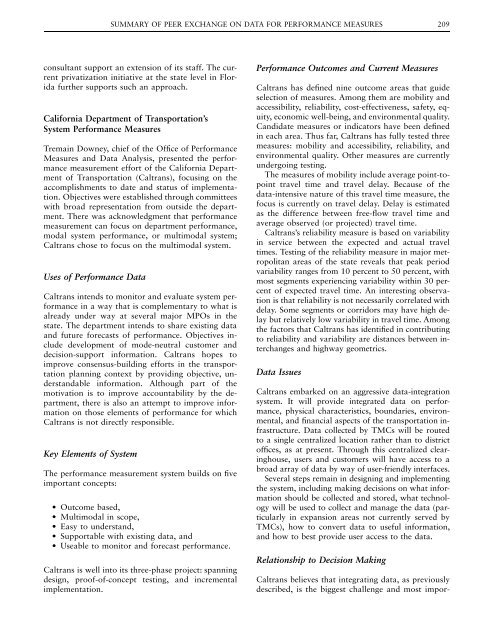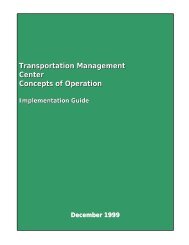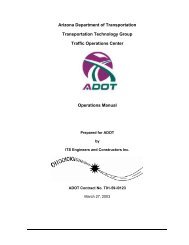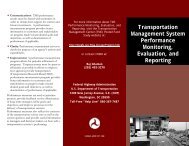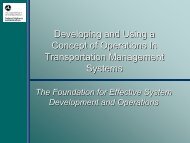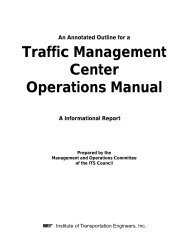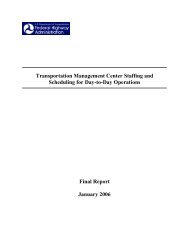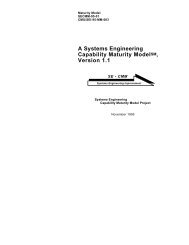Conference Proceedings 26 - Transportation Research Board
Conference Proceedings 26 - Transportation Research Board
Conference Proceedings 26 - Transportation Research Board
- No tags were found...
You also want an ePaper? Increase the reach of your titles
YUMPU automatically turns print PDFs into web optimized ePapers that Google loves.
SUMMARY OF PEER EXCHANGE ON DATA FOR PERFORMANCE MEASURES 209consultant support an extension of its staff. The currentprivatization initiative at the state level in Floridafurther supports such an approach.California Department of <strong>Transportation</strong>’sSystem Performance MeasuresTremain Downey, chief of the Office of PerformanceMeasures and Data Analysis, presented the performancemeasurement effort of the California Departmentof <strong>Transportation</strong> (Caltrans), focusing on theaccomplishments to date and status of implementation.Objectives were established through committeeswith broad representation from outside the department.There was acknowledgment that performancemeasurement can focus on department performance,modal system performance, or multimodal system;Caltrans chose to focus on the multimodal system.Uses of Performance DataCaltrans intends to monitor and evaluate system performancein a way that is complementary to what isalready under way at several major MPOs in thestate. The department intends to share existing dataand future forecasts of performance. Objectives includedevelopment of mode-neutral customer anddecision-support information. Caltrans hopes toimprove consensus-building efforts in the transportationplanning context by providing objective, understandableinformation. Although part of themotivation is to improve accountability by the department,there is also an attempt to improve informationon those elements of performance for whichCaltrans is not directly responsible.Key Elements of SystemThe performance measurement system builds on fiveimportant concepts:• Outcome based,• Multimodal in scope,• Easy to understand,• Supportable with existing data, and• Useable to monitor and forecast performance.Caltrans is well into its three-phase project: spanningdesign, proof-of-concept testing, and incrementalimplementation.Performance Outcomes and Current MeasuresCaltrans has defined nine outcome areas that guideselection of measures. Among them are mobility andaccessibility, reliability, cost-effectiveness, safety, equity,economic well-being, and environmental quality.Candidate measures or indicators have been definedin each area. Thus far, Caltrans has fully tested threemeasures: mobility and accessibility, reliability, andenvironmental quality. Other measures are currentlyundergoing testing.The measures of mobility include average point-topointtravel time and travel delay. Because of thedata-intensive nature of this travel time measure, thefocus is currently on travel delay. Delay is estimatedas the difference between free-flow travel time andaverage observed (or projected) travel time.Caltrans’s reliability measure is based on variabilityin service between the expected and actual traveltimes. Testing of the reliability measure in major metropolitanareas of the state reveals that peak periodvariability ranges from 10 percent to 50 percent, withmost segments experiencing variability within 30 percentof expected travel time. An interesting observationis that reliability is not necessarily correlated withdelay. Some segments or corridors may have high delaybut relatively low variability in travel time. Amongthe factors that Caltrans has identified in contributingto reliability and variability are distances between interchangesand highway geometrics.Data IssuesCaltrans embarked on an aggressive data-integrationsystem. It will provide integrated data on performance,physical characteristics, boundaries, environmental,and financial aspects of the transportation infrastructure.Data collected by TMCs will be routedto a single centralized location rather than to districtoffices, as at present. Through this centralized clearinghouse,users and customers will have access to abroad array of data by way of user-friendly interfaces.Several steps remain in designing and implementingthe system, including making decisions on what informationshould be collected and stored, what technologywill be used to collect and manage the data (particularlyin expansion areas not currently served byTMCs), how to convert data to useful information,and how to best provide user access to the data.Relationship to Decision MakingCaltrans believes that integrating data, as previouslydescribed, is the biggest challenge and most impor-


